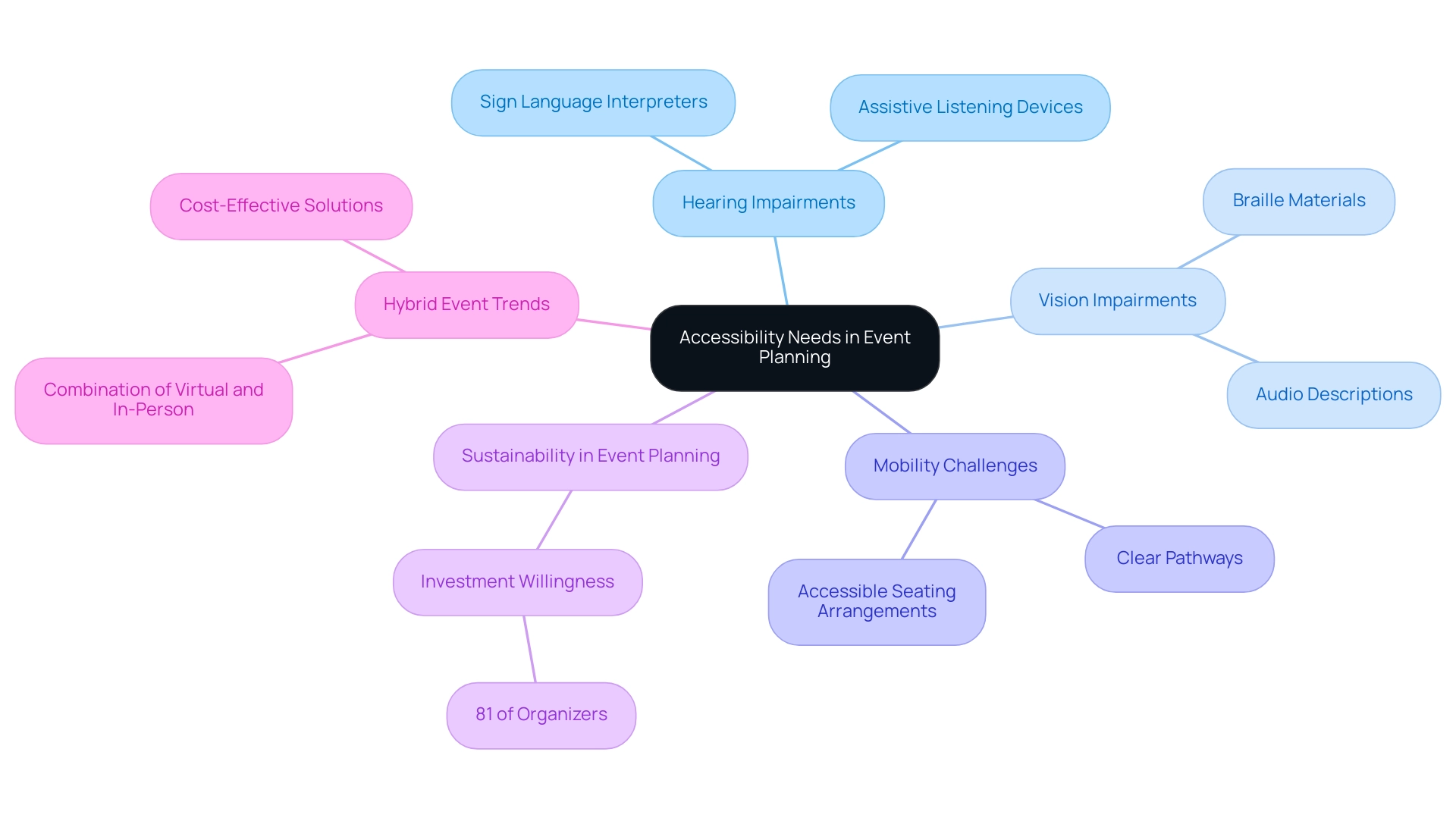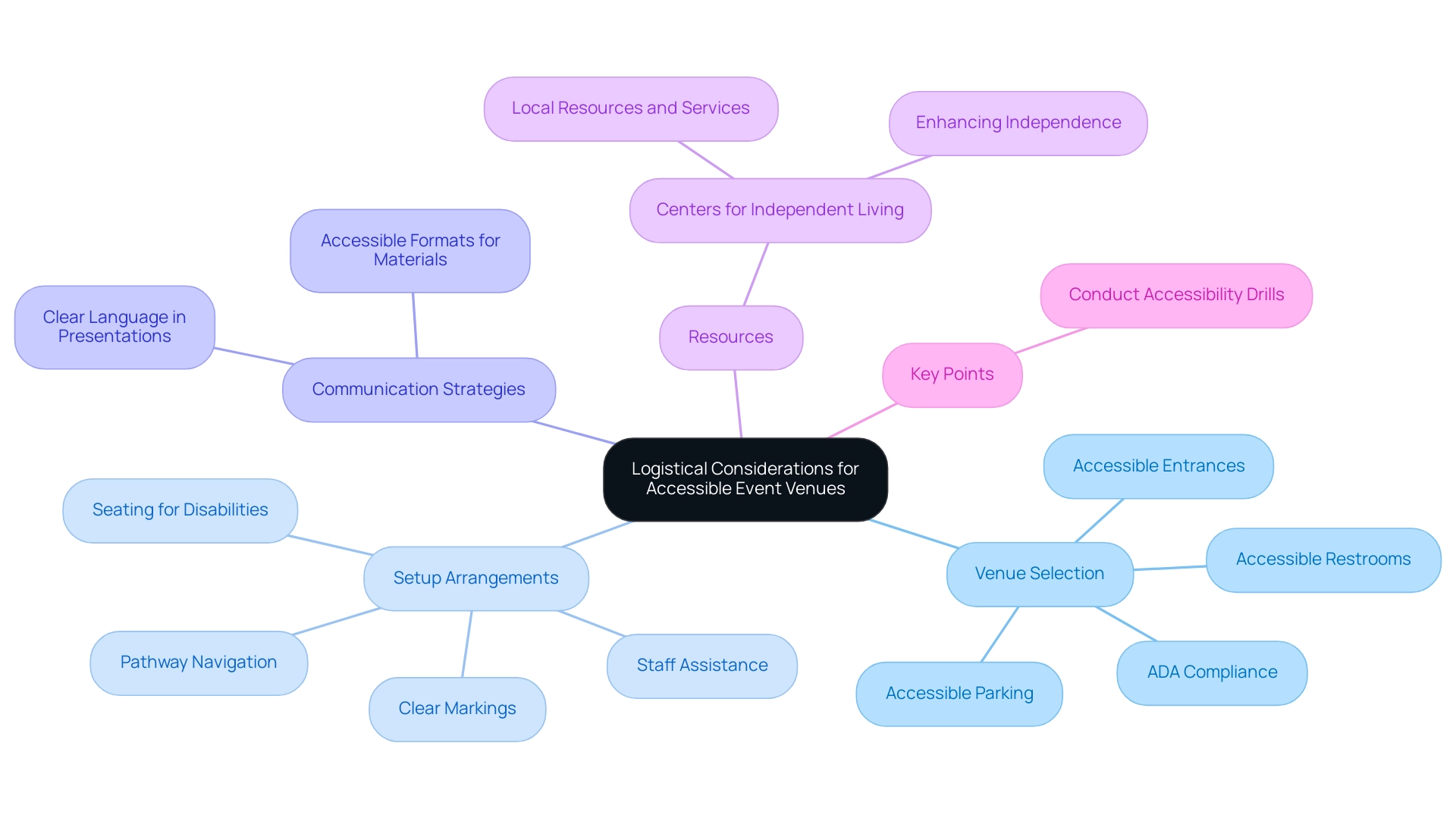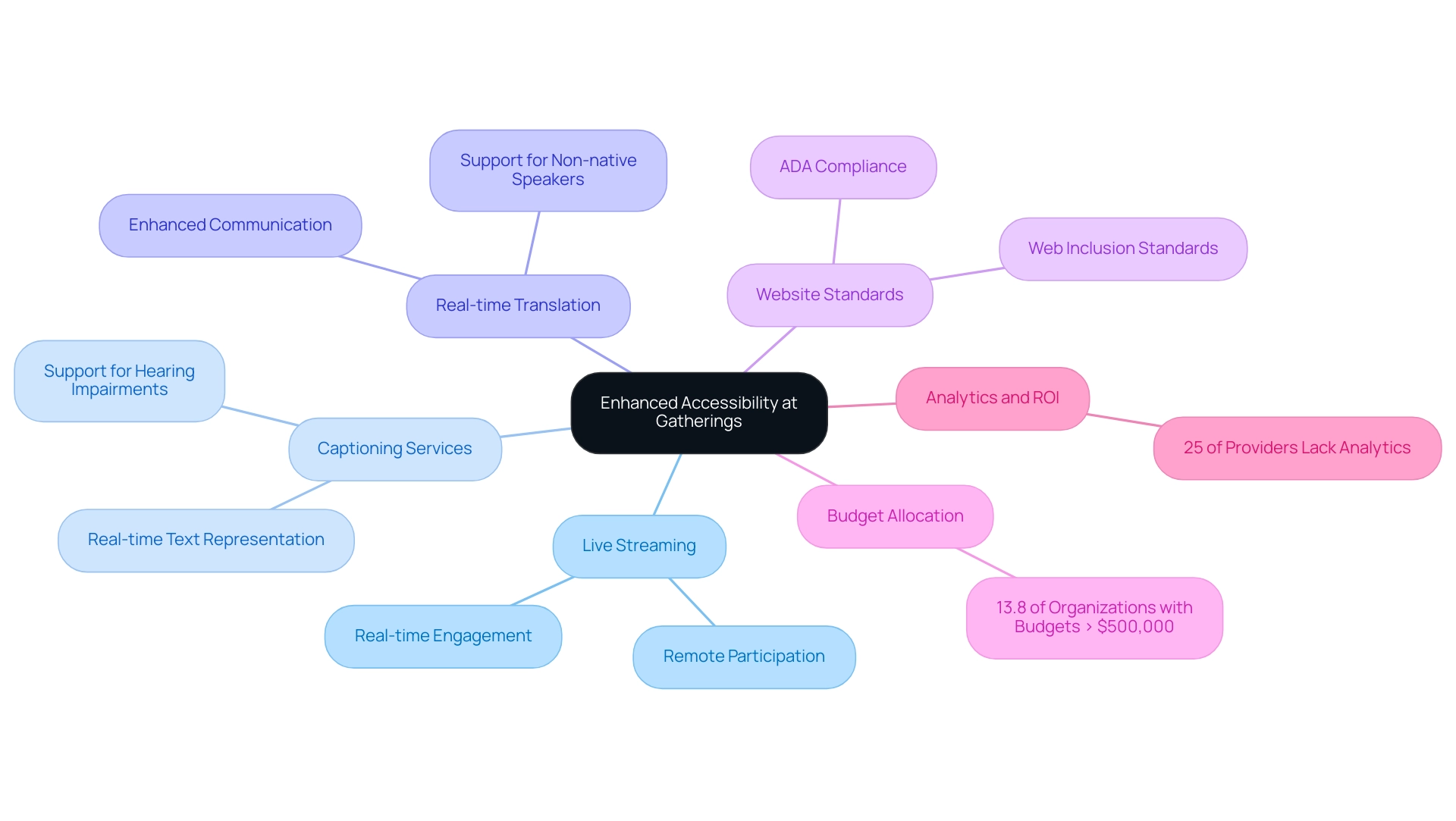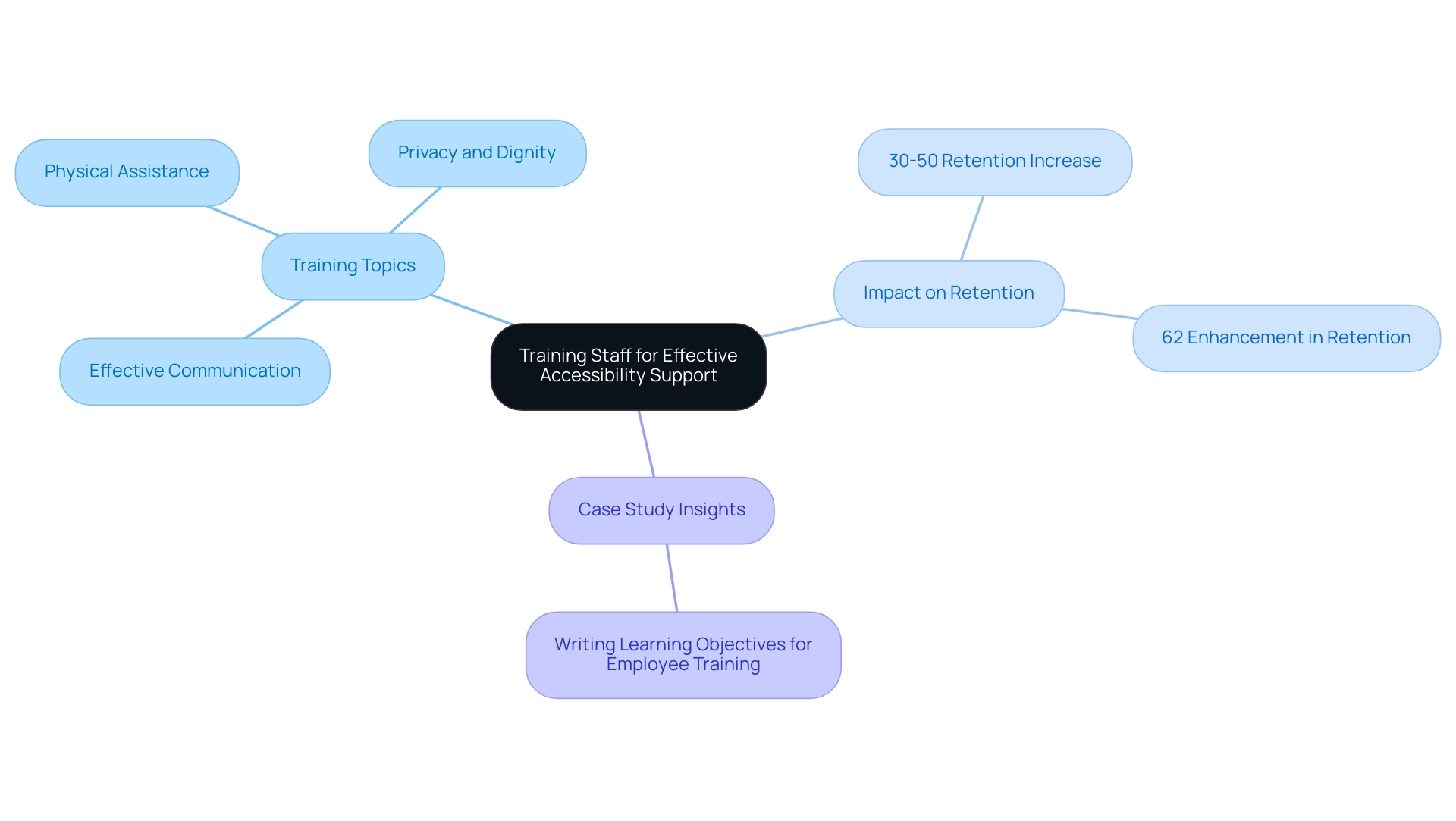Overview
To effectively plan an ADA event, it is crucial to understand and implement the Americans with Disabilities Act (ADA) guidelines, ensuring accessibility through physical venue access, alternative formats for materials, and clear signage. The article emphasizes that following these principles not only meets legal requirements but also enhances participant satisfaction and engagement, as demonstrated by the positive return on investment reported by sponsors of accessible events.
Introduction
Planning an accessible event is not merely a legal obligation; it is a commitment to inclusivity that can significantly enhance participant engagement and satisfaction. As the landscape of event planning evolves, understanding and implementing the Americans with Disabilities Act (ADA) guidelines becomes paramount. These guidelines provide a framework to ensure that all attendees, regardless of their abilities, can fully participate and benefit from the experience.
From selecting a venue that meets accessibility standards to employing technology that fosters inclusivity, every aspect of event planning requires careful consideration. This article delves into the fundamentals of accessible event planning, addressing diverse needs, logistical considerations, technological enhancements, and the importance of staff training.
By adopting best practices in these areas, event planners can create environments that are welcoming and accommodating for everyone.
Fundamentals of Planning an Accessible Event
To effectively plan an ADA event, it is essential to have a thorough understanding of the Americans with Disabilities Act (ADA) guidelines. These guidelines serve as a critical framework that ensures accessibility for all participants. Key principles encompass:
- Providing physical access to the venue
- Ensuring that elevators are operational in multi-story locations
- Deploying clear signage throughout the space
Furthermore, it is vital to offer materials in alternative formats to accommodate diverse needs. The arrangement of the gathering should be created with ease of movement in mind, particularly for individuals using mobility aids.
As Nancy Horton, a reviewer and editor, emphasizes, “Adhering to ADA event guidelines not only fulfills legal obligations but also demonstrates a commitment to inclusivity and respect for all attendees.” The importance of following these principles is highlighted by statistics showing that:
- 41% of professionals think occasions are the most effective marketing channel for achieving business objectives
- 72% of sponsors report a positive return on investment (ROI) from supporting accessible activities
Collaborating with consultants specializing in inclusivity can further improve your event planning process, offering customized insights and suggestions to tackle particular inclusivity challenges. For example, a recent case study on curb ramps and sidewalk usability highlights the importance of compliant design and maintenance in improving mobility and safety for individuals with disabilities. Event planners can apply these insights by ensuring that their venues include well-designed curb ramps and properly maintained sidewalks, facilitating easier access for all attendees.
Furthermore, the ADA National Network provides valuable resources and assistance for tackling accessibility challenges at gatherings, including contact information for regional centers across the United States. By implementing these best practices, planners can significantly enhance attendance and participant satisfaction at the ADA event while adhering to compliance.
Addressing Diverse Accessibility Needs in Event Planning
To ensure your ADA event is inclusive and accessible, begin your planning process with a thorough needs assessment. This involves surveying potential participants to identify their specific accessibility requirements. For those with hearing impairments, consider incorporating accommodations such as sign language interpreters or assistive listening devices.
For attendees with vision impairments, it is essential to provide Braille materials or audio descriptions to facilitate their participation. Additionally, for individuals facing mobility challenges, pathways should be clear and accessible, and seating arrangements must accommodate wheelchair users. By proactively addressing these various requirements, you cultivate an atmosphere in the ADA event where every participant feels valued and included.
Significantly, 81% of organizers are willing to invest more for gatherings conscious of sustainability in 2024, emphasizing the increasing trend towards accommodating various requirements in planning. As Hope Salvatori, Senior Content Marketing Associate at Cvent, highlights, ‘Recognizing the requirements of participants is essential for organizing successful gatherings, particularly in the context of an ADA event.’ Furthermore, the trend towards hybrid gatherings is gaining momentum; these formats blend the convenience of virtual attendance with the engaging aspects of in-person interactions, as illustrated in the case study ‘Trends in Hybrid and Virtual Gatherings.’
This approach not only broadens accessibility for all participants but also reflects a balance between convenience and engagement.
Logistical Considerations for Accessible Event Venues
Choosing a venue that adheres to ADA event standards is crucial for ensuring an inclusive experience for all participants. This includes verifying accessible entrances, restrooms, and parking facilities. During the setup, careful consideration must be given to the arrangement of seating, tables, and pathways to promote ease of navigation for all participants.
- Routes should be clearly marked, and staff assistance should be readily available when needed.
- Additionally, seating options should be reserved for individuals with hearing and vision disabilities to enhance their experience.
- Furthermore, effective communication strategies are essential:
- Presentations should utilize clear and concise language.
- Materials must be provided in accessible formats to support every participant’s needs.
As emphasized by industry specialists, ‘These statistics demonstrate that not only are gatherings one of the most important tactics for any business strategy, but that face-to-face interactions will always nurture and enhance customer relationships.’ Notably, 77% of all attendees say they trusted brands more after engaging in person with them at live gatherings. Implementing these measures not only complies with legal standards but also enhances the overall experience for individuals with disabilities at the ADA event. Moreover, resources like the Centers for Independent Living, which offer valuable assistance for individuals with disabilities, can be crucial in ensuring successful planning.
Leveraging Technology for Enhanced Accessibility
To enhance ease of access at gatherings, it is crucial to adopt technology-driven solutions like live streaming and captioning services. Live streaming enables remote participants to engage in real-time, promoting inclusivity regardless of physical location. Captioning services during presentations can significantly benefit individuals with hearing impairments by providing real-time text representation of spoken content.
Furthermore, with 13.8% of organizations having budgets surpassing $500,000 for virtual gatherings, there is a clear financial dedication towards improving participation through technology. Additionally, consider utilizing applications that offer real-time translation or transcription services to further enhance communication for non-native speakers. Making certain that your occasion website adheres to web inclusion standards is essential; this ensures that all participants can easily access important information related to the ADA event.
As noted, nearly 25 percent of virtual gathering technology providers don’t offer any analytics for proving sponsor ROI, which underscores the importance of measuring the effectiveness of inclusion solutions. By adopting these technological solutions, you foster an inclusive environment that accommodates the diverse needs of all participants, ultimately enhancing the experience. Moreover, the continual emphasis on diversity, equity, and inclusion (DE&I) in the gatherings industry reflects a wider dedication to sustainability and inclusivity, making accessibility a crucial element of responsible planning.
Training Staff for Effective Accessibility Support
To ensure that all participants, particularly those with disabilities, have a positive experience at your event, it is essential to conduct thorough training sessions for all staff and volunteers. This training should encompass a variety of critical topics, including:
- Effective communication strategies tailored to diverse needs
- Methods for providing physical assistance when necessary
- The paramount importance of respecting individual privacy and dignity
Engaging staff to proactively interact with attendees fosters an inclusive and welcoming atmosphere.
Evidence indicates that organizations with strong training programs observe a retention rate rise of 30-50%, emphasizing the significance of a solid learning culture in supporting inclusion initiatives. Moreover, organizations that utilize educational platforms tailored for various audiences indicate a 62% enhancement in employee retention, in contrast to only 30% for those concentrating exclusively on staff, highlighting how extensive training can result in improved retention and overall success.
To facilitate effective training, consider implementing insights from the case study ‘Writing Learning Objectives for Employee Training,’ which provides a practical framework for developing clear learning objectives tailored specifically for training staff on support.
By equipping your team with the knowledge and skills to support accessibility, you not only enhance the overall experience for everyone but also contribute to the long-term success of your events.
Conclusion
Planning an accessible event is a multifaceted endeavor that requires a thorough understanding of the Americans with Disabilities Act (ADA) guidelines, a commitment to inclusivity, and a focus on the diverse needs of all participants. Key considerations include:
- Selecting venues that meet accessibility standards
- Implementing technology solutions that enhance participation
- Conducting thorough training for staff to ensure effective support for attendees with disabilities
The importance of addressing diverse accessibility needs cannot be overstated. By conducting needs assessments and providing accommodations such as:
- Sign language interpreters
- Braille materials
event planners can create an environment where every participant feels included and valued. Logistical considerations, such as ensuring clear pathways and accessible seating, further enhance the overall experience for attendees.
Additionally, leveraging technology plays a crucial role in fostering inclusivity. Solutions like live streaming and captioning not only broaden access but also enrich the event experience for all participants. Moreover, investing in staff training ensures that team members are equipped to provide the necessary support, creating a welcoming atmosphere for everyone.
In summary, prioritizing accessibility in event planning is not just a legal requirement but a strategic advantage that enhances participant engagement and satisfaction. By embracing best practices in accessibility, event planners can create inclusive environments that cater to the needs of all attendees, ultimately leading to more successful and impactful events.
Frequently Asked Questions
What are the key principles for planning an ADA event?
The key principles for planning an ADA event include providing physical access to the venue, ensuring that elevators are operational in multi-story locations, and deploying clear signage throughout the space.
Why is it important to provide materials in alternative formats at an ADA event?
Providing materials in alternative formats is essential to accommodate diverse needs, ensuring that all participants can access and engage with the event content effectively.
How can event planners ensure ease of movement for individuals using mobility aids?
Event planners can ensure ease of movement by arranging the gathering with clear pathways and accessible seating that accommodates wheelchair users and individuals using mobility aids.
What does Nancy Horton emphasize about adhering to ADA event guidelines?
Nancy Horton emphasizes that adhering to ADA event guidelines not only fulfills legal obligations but also demonstrates a commitment to inclusivity and respect for all attendees.
What statistics highlight the effectiveness of accessible events in marketing?
Statistics show that 41% of professionals believe events are the most effective marketing channel for achieving business objectives, and 72% of sponsors report a positive return on investment (ROI) from supporting accessible activities.
How can collaborating with consultants improve ADA event planning?
Collaborating with consultants specializing in inclusivity can provide customized insights and suggestions to tackle specific inclusivity challenges, enhancing the overall planning process.
What resources does the ADA National Network offer for event planners?
The ADA National Network provides valuable resources and assistance for addressing accessibility challenges at gatherings, including contact information for regional centers across the United States.
What should organizers do to assess the accessibility needs of participants?
Organizers should begin the planning process with a thorough needs assessment by surveying potential participants to identify their specific accessibility requirements.
What accommodations can be made for participants with hearing impairments?
Accommodations for participants with hearing impairments may include sign language interpreters or assistive listening devices.
What accommodations should be provided for attendees with vision impairments?
For attendees with vision impairments, it is essential to provide Braille materials or audio descriptions to facilitate their participation.
How does the trend towards hybrid gatherings contribute to accessibility?
The trend towards hybrid gatherings blends the convenience of virtual attendance with the engaging aspects of in-person interactions, broadening accessibility for all participants.




